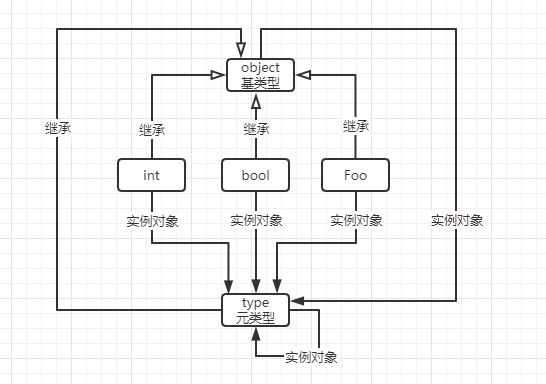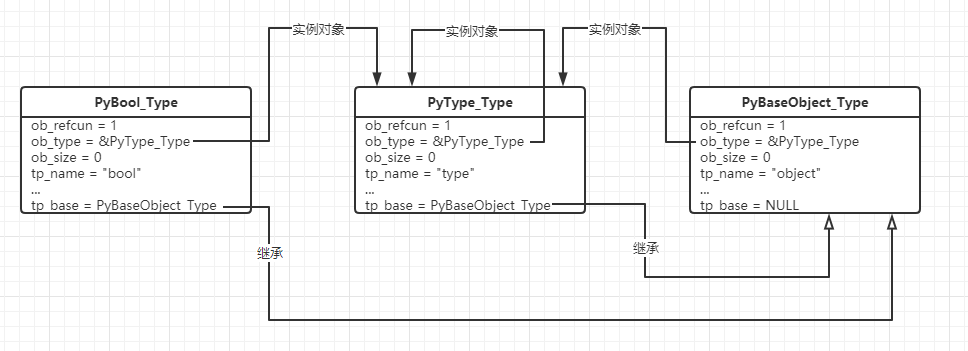Python 源码学习(1):类型和对象
Python 是一门解释型,动态类型,多范式的编程语言,当我们从 python.org 下载并安装运行 Python 的某个分发版本时,我们实际上是在运行由 C 语言编写的 CPython,除此之外 Python 的运行时还有 Jython, PyPy, Cython 等;CPython 的源码中有一系列的库,组件和工具:
$ git clone https://github.com/python/cpython
$ tree -d -L 2 .
.
`-- cpython
|-- Doc # 文档
|-- Grammar
|-- Include # C 头文件
|-- Lib # 用 Python 写的库文件
|-- Mac # 用于在 macOS 上构建的文件
|-- Misc # 杂项
|-- Modules # 用 C 写的库文件
|-- Objects # 核心类型,以及对象模型的定义
|-- PC # 用于在 Windows 上构建的文件
|-- PCbuild # 用于在老版本的 Windows 上构建的文件
|-- Parser # Python 解析器源码
|-- Programs # Python 可执行文件和其他
|-- Python # CPython 编译器源码
|-- Tools # 构建时的工具
`-- m4
16 directories
本系列主要以阅读和分析 CPython 源码的方式学习 Python。
1 对象模型
Python 是一门面向对象的语言,我们可以使用 Python 中的 type() 函数查看一个对象所属的类:
>>> type(1)
<class 'int'>
>>> type(True)
<class 'bool'>
可以看到整数对象和布尔值对象的类型分别是 <class 'int'> 和 <class 'bool'>;
而实际上,在 Python 中无论是整数,布尔值还是基本数据类型,甚至自定义的 class,都是对象:
class Foo:
pass
print(type(int))
print(type(Foo))
<class 'type'>
<class 'type'>
可以看到 int 类型和自定义类 Foo 的类型都是 <class 'type'>,它们是 type 这个类的实例对象;type 类型是专门用于定义类型的类型,也称为元类型;实际上, type 这个类型本身也是一个对象,它所属的类也是 type:
>>> type(type)
<class 'type'>
同时,Python 中的所有类型,无论是 int, type, 还是自定义类 Foo 都是继承自一个叫 object 的基类,而 object 则是继承链的终点:
>>> int.__base__
<class 'object'>
>>> type.__base__
<class 'object'>
>>> print(Foo.__base__)
<class 'object'>
>>> print(object.__base__)
None
而 object 基类也是一个 type 类型的对象:
>>> type(object)
<class 'type'>
上面的关系用图表达出来则是:

可以看到,所有类型的基类都是 object,所有类型的类型都是 type,这就是 Python 的对象模型(object model),也是 Objects/ 目录下源码所包含的内容。
2 核心类型与对象
虽然在 Python 的语法层面有非常多所谓的类型(包括 int, type, Foo 等),但实际上它们在源码(C 语言)层面上都是结构体对象。
2.1 对象
PyObject
Python 中所有的类型都由 PyObject 结构体扩展而来,这个结构体中有以下几个成员变量:
Py_ssize_t ob_refcnt用于保存对象的引用计数;PyTypeObject *ob_type指向对象的类型对象,用来标识对象属于的类型,并存储类型的元数据;_PyObject_HEAD_EXTRA宏代表了两个PyObject*双向链表的指针,用于把堆上的所有对象链接起来,只会在开启了Py_TRACE_REFS宏的时候进行构造,方便调试;
// Include/object.h
/* Define pointers to support a doubly-linked list of all live heap objects. */
#define _PyObject_HEAD_EXTRA \
struct _object *_ob_next; \
struct _object *_ob_prev;
/* Nothing is actually declared to be a PyObject, but every pointer to
* a Python object can be cast to a PyObject*. This is inheritance built
* by hand. Similarly every pointer to a variable-size Python object can,
* in addition, be cast to PyVarObject*.
*/
typedef struct _object {
_PyObject_HEAD_EXTRA // 双向链表,用于追踪堆中所有对象,在开启了 Py_TRACE_REFS 宏的时候有用
Py_ssize_t ob_refcnt; // 引用计数,用于垃圾回收
PyTypeObject *ob_type; // 指针,指向当前对象的类型对象,用于查询对象的类型
} PyObject;
PyVarObject
Python 中有可以自由修改长度的 PyVarObject 变长对象,它由一个 PyObject 对象和一个存储变长部分的长度(元素个数)的变量 ob_size 组成:
typedef struct {
PyObject ob_base;
Py_ssize_t ob_size; /* Number of items in variable part */
} PyVarObject;
PyObject 和 PyVarObject 一般是作为头部被包含在一个变量结构体中的,根据该变量大小是否固定来选择使用哪一种:
// Include/object.h
/* PyObject_HEAD defines the initial segment of every PyObject. */
#define PyObject_HEAD PyObject ob_base;
/* PyObject_VAR_HEAD defines the initial segment of all variable-size
* container objects. These end with a declaration of an array with 1
* element, but enough space is malloc'ed so that the array actually
* has room for ob_size elements. Note that ob_size is an element count,
* not necessarily a byte count.
*/
#define PyObject_VAR_HEAD PyVarObject ob_base;
Python 中最典型的变长对象就是列表 List,它和 std::vector 比较类似,列表对象里有三个成员变量,包括:
- 基础的变长对象
PyVarObject ob_base,其中ob_base.ob_size用于表示列表当前的元素个数; - 指向动态数组的指针
PyObject **ob_item; - 动态数组当前的容量
Py_ssize_t allocated:
// Inlucde/cpython/listobject.h
typedef struct {
PyObject_VAR_HEAD
/* Vector of pointers to list elements. list[0] is ob_item[0], etc. */
PyObject **ob_item;
/* ob_item contains space for 'allocated' elements. The number
* currently in use is ob_size.
* Invariants:
* 0 <= ob_size <= allocated
* len(list) == ob_size
* ob_item == NULL implies ob_size == allocated == 0
* list.sort() temporarily sets allocated to -1 to detect mutations.
*
* Items must normally not be NULL, except during construction when
* the list is not yet visible outside the function that builds it.
*/
Py_ssize_t allocated;
} PyListObject;
2.2 类型
PyTypeObject
PyObject 类中的 PyTypeObject *ob_type 是一个指向对象类型的指针,它是类在 Python 中的表现形式;PyTypeObject 不仅决定了 PyObject 对象属于什么类型,还包含了非常多的元数据,例如:
PyObject_VAR_HEAD表示PyTypeObject本身是一个变长对象;const char *tp_name表示类型的名字;struct _typeobject *tp_base是指向基类的指针,保存类型的继承信息;Py_ssize_t tp_basicsize, tp_itemsize表示创建实力对象时分配的内存大小;setattrfunc tp_setattr设置值,getattrfunc tp_getattr获取值,destructor tp_dealloc析构,hashfunc tp_hash哈希等函数指针表示该类型所支持的标准操作;
// Include/object.h
/* PyTypeObject structure is defined in cpython/object.h.
In Py_LIMITED_API, PyTypeObject is an opaque structure. */
typedef struct _typeobject PyTypeObject;
// Include/cpython/object.h
struct _typeobject {
PyObject_VAR_HEAD // 即 PyVarObject ob_base;
const char *tp_name; /* For printing, in format "<module>.<name>" */
Py_ssize_t tp_basicsize, tp_itemsize; /* For allocation */
/* Methods to implement standard operations */
destructor tp_dealloc;
Py_ssize_t tp_vectorcall_offset;
getattrfunc tp_getattr;
setattrfunc tp_setattr;
PyAsyncMethods *tp_as_async; /* formerly known as tp_compare (Python 2)
or tp_reserved (Python 3) */
// Strong reference on a heap type, borrowed reference on a static type
struct _typeobject *tp_base;
/* More standard operations (here for binary compatibility) */
// ...
};
Python 中的每一种类型对象都是全局唯一的,他们在源码中以全局变量的形式存在,例如 int 类型:
// Objects/longobject.c
PyTypeObject PyLong_Type = {
PyVarObject_HEAD_INIT(&PyType_Type, 0)
"int", /* tp_name */
offsetof(PyLongObject, ob_digit), /* tp_basicsize */
sizeof(digit), /* tp_itemsize */
0, /* tp_dealloc */
0, /* tp_vectorcall_offset */
0, /* tp_getattr */
0, /* tp_setattr */
0, /* tp_as_async */
long_to_decimal_string, /* tp_repr */
&long_as_number, /* tp_as_number */
// ...
};
PyVarObject_HEAD_INIT 宏用于初始化 PyVarObject 中的 ob_refcnt, ob_type 和 ob_size:
#define PyObject_HEAD_INIT(type) \
{ 1, type },
#define PyVarObject_HEAD_INIT(type, size) \
{ PyObject_HEAD_INIT(type) size },
可以看到在 PyLong_Type 中,ob_type 被初始化为 &PyType_Type,它是专门用于定义类型对象的类型,抑或叫做类型的类型或原类型。
PyType_Type
在前面已经了解到,type 类型对象所属的类也是 type,那么类型对象 PyTypeObject 本身也是一个类对象,它也拥有指向其类型对象的指针 PyTypeObject *ob_type;对于类型对象本身来说,它的类型对象都基于一个叫做 PyType_Type(即元类型)的 PyTypeObject 类对象:
// Objects/typeobject.c
PyTypeObject PyType_Type = {
PyVarObject_HEAD_INIT(&PyType_Type, 0) // PyType_Type 在初始化的时候将指向自身的指针传递并用于构造了一个 PyVarObject 类型的对象 ob_base,其中 ob_base->ob_type = &PyType_Type,参考附录 1
"type", /* tp_name */
sizeof(PyHeapTypeObject), /* tp_basicsize */
sizeof(PyMemberDef), /* tp_itemsize */
(destructor)type_dealloc, /* tp_dealloc */
offsetof(PyTypeObject, tp_vectorcall), /* tp_vectorcall_offset */
// ...
};
Python 中类型对象都定义在了 Objects/ 目录下,例如 bool 类型:
// Objects/boolobject.c
/* The type object for bool. Note that this cannot be subclassed! */
PyTypeObject PyBool_Type = {
PyVarObject_HEAD_INIT(&PyType_Type, 0) // 同 PyType_Type,ob_base->ob_type = &PyType_Type
"bool", // tp_name = "bool"
sizeof(struct _longobject), /* tp_basicsize */
0, /* tp_itemsize */
0, /* tp_dealloc */
0, /* tp_vectorcall_offset */
0, /* tp_getattr */
0, /* tp_setattr */
0, /* tp_as_async */
bool_repr, /* tp_repr */
&bool_as_number, /* tp_as_number */
// ...
0, /* tp_base */
// ...
};
在 Python 中,无论是内建类型(int, bool 等),还是自定义类型(Foo),都是通过 PyTypeObject 这个结构体构造的,且一定满足 ob_base->ob_type = &PyType_Type。
前文提到 tp_base 是指向基类的指针,保存类型的继承信息,但实际上在定义 PyBool_Type 的时候可以看到 tp_base = 0,实际上这个 tp_base 是在 PyType_Ready 函数中被赋值为 PyBaseObject_Type 的:
// Objects/typeobject.c
int
PyType_Ready(PyTypeObject *type)
{
PyTypeObject *base;
// ...
/* Initialize tp_base (defaults to BaseObject unless that's us) */
base = type->tp_base;
if (base == NULL && type != &PyBaseObject_Type) {
base = &PyBaseObject_Type;
if (type->tp_flags & Py_TPFLAGS_HEAPTYPE) {
type->tp_base = (PyTypeObject*)Py_NewRef((PyObject*)base);
}
else {
type->tp_base = base;
}
}
// ...
}
这里 PyTypeObject *base 被赋值为的 PyBaseObject_Type 就是前文提到的基类型。
PyBaseObject_Type
PyBaseObject_Type 定义在 typeobject.c 文件中:
// Objects/typeobject.c
PyTypeObject PyBaseObject_Type = {
PyVarObject_HEAD_INIT(&PyType_Type, 0) // 同 PyType_Type,ob_base->ob_type = &PyType_Type
"object", /* tp_name */
sizeof(PyObject), /* tp_basicsize */
0, /* tp_itemsize */
object_dealloc, /* tp_dealloc */
// ...
object_repr, /* tp_repr */
// ...
0, /* tp_base */
// ...
};
可以看到无论是 PyBool_Type,PyType_Type 还是 PyBaseObject_Type,都有两个共同点:
- 它们是以同样的方式
PyVarObject_HEAD_INIT(&PyType_Type, 0)定义其类型的,因此它们的类型都是PyTypeObject; - 它们指向基类的指针
tp_base初始化时都是 NULL;
不同的地方是,在使用 PyType_Ready 函数为它们的基类指针 tp_base 赋值时,只有 PyBaseObject_Type.tp_base 不会被赋值,其他的 tp_base 则都会被赋值为 PyBaseObject_Type,这也印证了 PyBaseObject_Type 是继承链的终点。
我们可以将上面的关系整理为一个图:

附录
1 PyType_Type 构造
struct Bar;
struct Foo
{
Bar* p_b;
int ref_count;
};
struct Bar
{
Foo f;
const char* name;
};
Bar b
{
Foo{ &b, 1 },
"ClassBar"
};
int main()
{
printf("%s\n", b.f.p_b->name);
return 0;
}
$ ./test
ClassBar